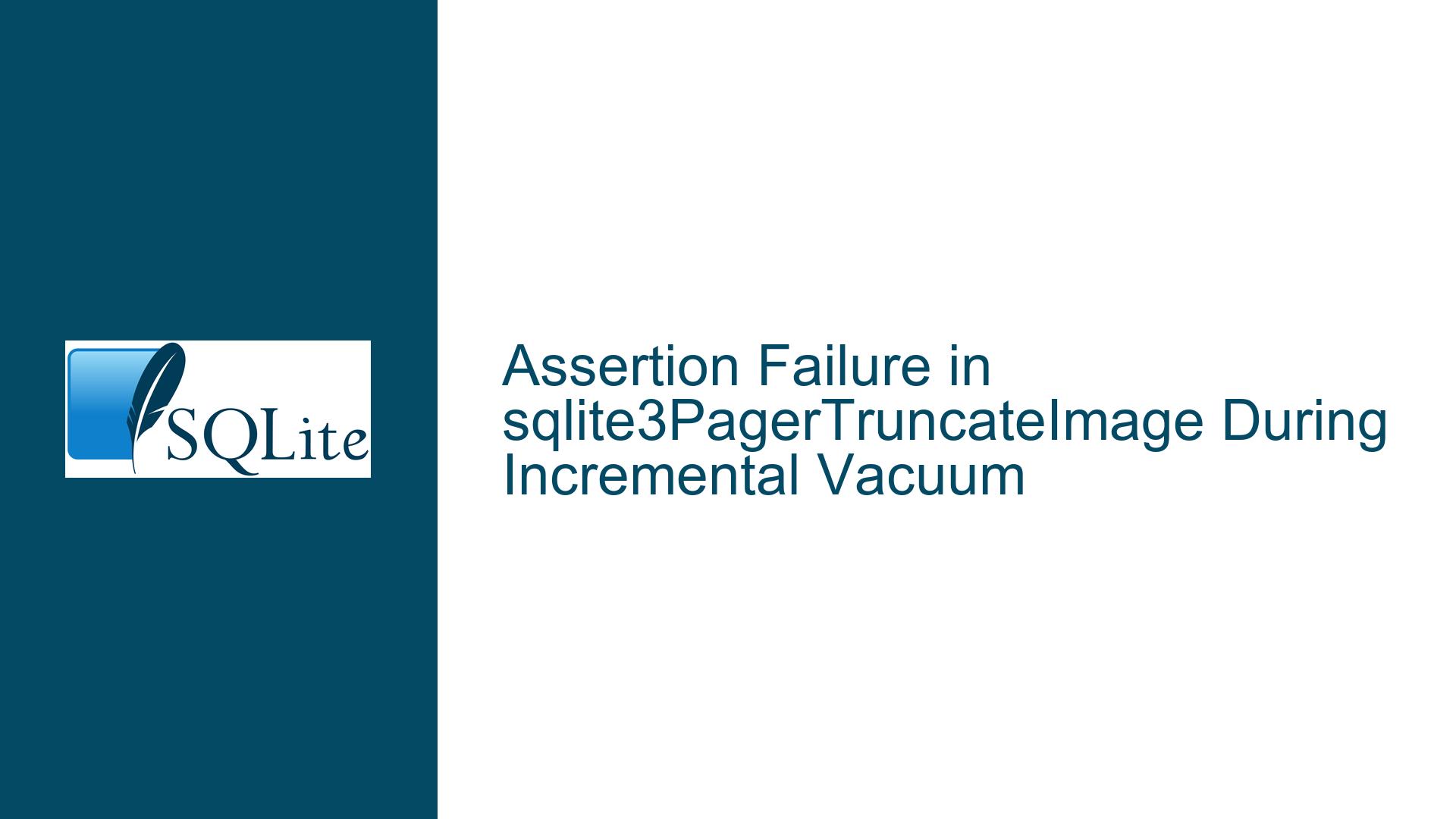Assertion Failure in sqlite3PagerTruncateImage During Incremental Vacuum
Understanding the Assertion Failure in sqlite3PagerTruncateImage
The core issue revolves around an assertion failure in the sqlite3PagerTruncateImage function, which occurs during the execution of a sequence of SQL statements involving incremental vacuuming, table creation, and deletion. The assertion failure is triggered when the database engine attempts to truncate the database file to a smaller size, but the operation violates a critical condition in the pager layer. Specifically, the assertion pPager->dbSize >= nPage || CORRUPT_DB fails, indicating that the database size (dbSize) is smaller than the requested truncation size (nPage), or the database is corrupt.
The error message database or disk is full (13) suggests that the database engine encountered a resource limitation, but the assertion failure points to a deeper issue in the pager layer. The pager is responsible for managing the database file’s pages, including reading, writing, and truncating them. The assertion ensures that the database size is always greater than or equal to the number of pages being truncated, or else the database is considered corrupt. This failure indicates a mismatch between the pager’s internal state and the actual database file size, which could stem from several underlying causes.
The sequence of operations leading to the failure involves enabling incremental vacuuming, creating a table, inserting a large blob, setting a low max_page_count, deleting all rows, and then attempting an incremental vacuum. The .testctrl n 4 command further complicates the scenario by introducing a test control mechanism that may alter the database engine’s behavior. This combination of operations creates a high-stress environment for the pager, making it susceptible to edge cases and internal state inconsistencies.
Potential Causes of the Assertion Failure
The assertion failure in sqlite3PagerTruncateImage can be attributed to several potential causes, each of which interacts with the pager’s internal state and the database file’s physical structure. Understanding these causes requires a deep dive into SQLite’s pager layer, incremental vacuuming, and the interaction between database operations and resource limits.
1. Mismatch Between Pager State and Database File Size
The most immediate cause of the assertion failure is a mismatch between the pager’s internal state (pPager->dbSize) and the actual size of the database file. This mismatch can occur if the pager fails to update its internal state correctly after a truncation operation or if the truncation operation itself is interrupted or incomplete. In this case, the pager believes the database file is larger than it actually is, leading to the assertion failure when attempting to truncate it further.
2. Resource Limitations and Disk Full Errors
The error message database or disk is full (13) suggests that the database engine encountered a resource limitation during the incremental vacuum operation. This limitation could be due to the max_page_count setting, which restricts the database file to a maximum of two pages. When combined with the insertion of a large blob and subsequent deletion, the database engine may struggle to manage the file’s size within the imposed limit, leading to an inconsistent state.
3. Incremental Vacuuming and Page Reuse
Incremental vacuuming is designed to reclaim free pages from the database file without requiring a full vacuum. However, this process relies on the pager’s ability to track and manage free pages accurately. If the pager’s free page list becomes inconsistent due to concurrent operations or resource limitations, the incremental vacuum operation may attempt to truncate pages that are still in use or fail to update the pager’s internal state correctly.
4. Test Control Mechanism Interference
The .testctrl n 4 command introduces a test control mechanism that may alter the database engine’s behavior in ways that are not fully understood. This mechanism could interfere with the pager’s normal operation, leading to state inconsistencies or unexpected truncation behavior. The exact impact of this command depends on its implementation and how it interacts with the pager and incremental vacuuming.
5. Compilation Flags and Debugging Features
The compilation flags used to build SQLite, such as -DSQLITE_DEBUG and -DSQLITE_ENABLE_TREETRACE, enable additional debugging and tracing features that may expose edge cases or internal state inconsistencies. While these features are invaluable for diagnosing issues, they can also introduce additional overhead or alter the database engine’s behavior in subtle ways, potentially contributing to the assertion failure.
Diagnosing and Resolving the Assertion Failure
Resolving the assertion failure in sqlite3PagerTruncateImage requires a systematic approach to diagnose the root cause and implement appropriate fixes. The following steps outline a comprehensive troubleshooting process, including potential solutions and workarounds.
1. Verify Database Integrity
The first step is to verify the integrity of the database file using the PRAGMA integrity_check command. This command checks for corruption and inconsistencies in the database file, which could explain the assertion failure. If the integrity check reveals issues, the database may need to be repaired or restored from a backup.
2. Review Resource Limits and Configuration
The max_page_count setting and disk space limitations play a critical role in the assertion failure. Review the database configuration to ensure that resource limits are set appropriately for the workload. Increasing the max_page_count or freeing up disk space may alleviate the issue, but it is essential to understand the trade-offs and implications of these changes.
3. Analyze Incremental Vacuuming Behavior
Incremental vacuuming is a complex operation that interacts closely with the pager. Analyze the behavior of the incremental vacuum operation by enabling additional logging and tracing using the SQLITE_ENABLE_TREETRACE and SQLITE_ENABLE_WHERETRACE flags. This analysis can help identify inconsistencies in the pager’s free page list or truncation logic.
4. Investigate Test Control Mechanism Impact
The .testctrl n 4 command may be contributing to the assertion failure by altering the database engine’s behavior. Investigate the implementation and purpose of this command to understand its impact on the pager and incremental vacuuming. If possible, disable or modify the command to isolate its effects.
5. Review Compilation Flags and Debugging Features
The compilation flags used to build SQLite may expose edge cases or introduce additional overhead. Review the flags and consider rebuilding SQLite with a minimal set of debugging features to determine if they are contributing to the assertion failure. This step can help isolate the issue and identify potential optimizations.
6. Implement Workarounds and Fixes
If the root cause cannot be immediately identified or resolved, consider implementing workarounds to mitigate the issue. For example, disabling incremental vacuuming or using a full vacuum operation may avoid the assertion failure. Additionally, modifying the sequence of operations or adjusting resource limits may provide a temporary solution while further investigation is ongoing.
7. Engage with the SQLite Community
If the issue persists, consider engaging with the SQLite community or submitting a bug report. Provide detailed information about the assertion failure, including the sequence of operations, compilation flags, and any relevant logs or traces. The community may be able to provide additional insights or identify a known issue.
By following these steps, you can systematically diagnose and resolve the assertion failure in sqlite3PagerTruncateImage, ensuring the stability and integrity of your SQLite database.






